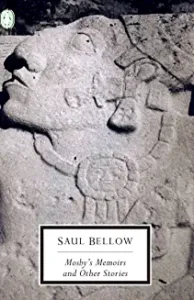Mosby’s Memoirs and Other Stories by Saul Bellow 1968
Saul Bellow has been one of my favorite authors since I read ‘Herzog’ nearly 60 years ago. Several years back, I managed to read nearly all of his works, some little known and others quite famous, though at the time, I wasn’t aware of his short stories.
The son of Jewish immigrants from Vilnius via St. Petersburg, he was born in Quebec but his family moved when he was 8 years old to Chicago which became his long time home and the setting for many of his works. He was known primarily for his novels winning the National Book Award three times for ‘The Adventures of Augie March’ in 1953, ‘Herzog’ in 1964, and ‘Mr. Sammler’s Planet’ in 1970 , the Pulitzer Prize for ‘Humboldt’s Gift’ in 1975, and the Nobel Prize for Literature in 1976. He taught at a number of major universities finishing his teaching career at Boston University where he co-taught a course with one of my favorite literary critics, James Wood. Bellow was married five times. He died in 2005 at the age of 89 and is buried in the Jewish cemetery in Brattleboro, Vermont.
The six stories in ‘Mosby’s Memoirs’ were written between 1955, when Bellow was 40 and 1968 when the eponymous title story was published in The New Yorker. While writing 14 major novels, he published only three collections of short stories in addition to his Collected volume, but his style, power, and talent were clearly evident in these early works. Jewish characters predominate but the first story’s main character is an older, single woman living in the desert in the Far West and ‘Looking for Mr. Green’ features an Irish civil servant trying to deliver welfare checks in a Black neighborhood in Chicago. What is present in all of the stories is Bellow’s versatility and power in character, place, plot and dialogue. What remains true characteristic in all of them is the pace and power of the prose. There are places in most of the stories where there is no break in the solid wall of sentences that fill the page as Bellow hurtles down the path of getting his characters thoughts and anxieties down on paper.
While I enjoyed all the stories, I particularly liked ‘The Old System’ in which the family breakdowns around money in a second generation immigrant Jewish family were wonderfully and painfully rendered. Here is a sample of Bellow’s writing from that story: “Oh, these Jews—these Jews! Their feelings, their hearts! Dr. Braun often wanted nothing more than to stop all this. For what came of it? One after another you gave over your dying. One by one they went. You went. Childhood, family, friendship, love were stifled in the grave. And these tears! When you wept them from the heart, you felt you justified something, understood something. But what did you understand? Again, nothing!” There’s Bellow, fervent, angry, wounded, confused about the meaning of life and how to live it well—-it’s all there and powerfully written in every one of these stories. As the Nobel Committee wrote, he was awarded the Prize “for the human understanding and subtle analysis of contemporary culture that are combined in his work”. Read Bellow by all means, but I’d recommend that you read the novels. Read ‘Augie March’, ‘Herzog’, and his first two novels, ‘Dangling Man’ and ‘The Victim’ to experience great writing.
(An aside for a moment, please. You will note that the cover of the Penguin edition that is featured above has some sort of Aztec or Mayan hieroglyph. I guess there might be a tenuous relationship between that image and the eponymous story where Mosby is writing his memoirs in Mexico, but really? The edition that I read was a hard cover book published by the Viking Press with a black background, Bellow’s name in large white letters above the title in smaller blue letters. I liked it very much, but I am often unable to locate long out of print edition covers and I’m thus reduced to using one of the more garish modern covers. Ugh!).



